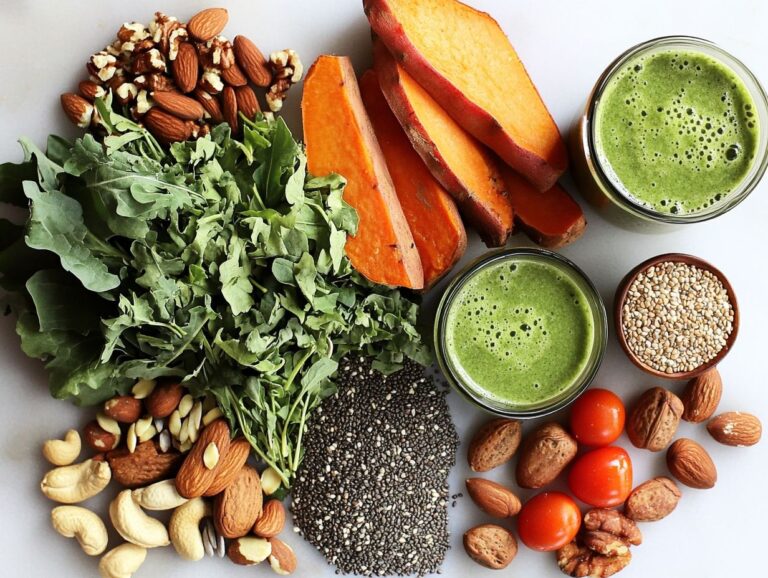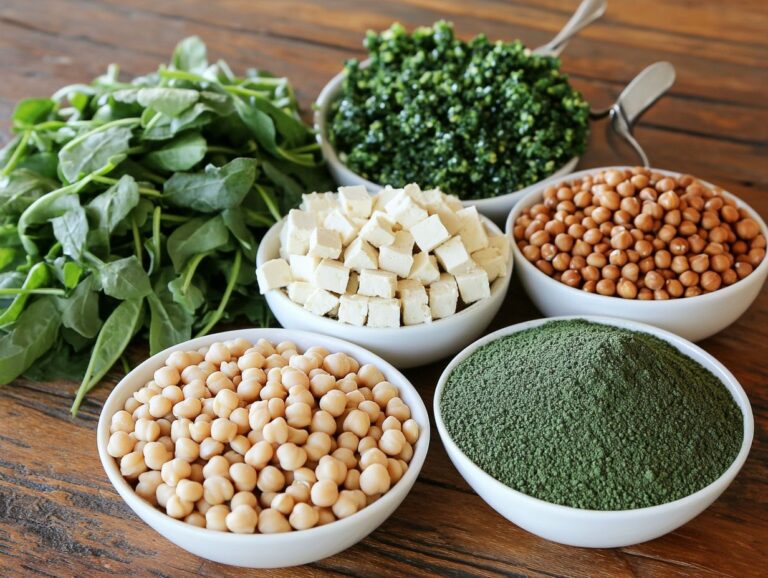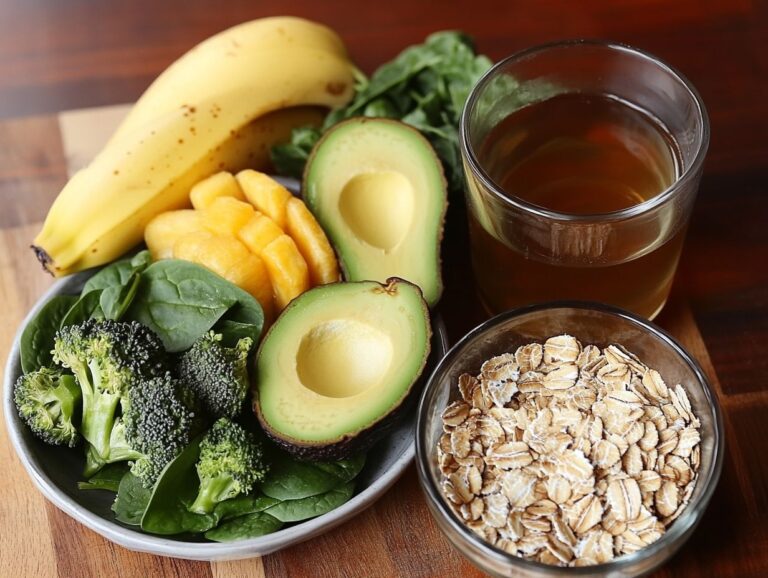Embarking on a low-fiber vegan diet can be a unique and beneficial journey for individuals dealing with digestive issues, specific medical conditions like Crohn’s disease, or personal preferences. This article delves into the essentials of a low-fiber vegan diet, outlining the reasons for adopting such a lifestyle as well as the foods to include and avoid. Additionally, it offers guidance on maintaining proper nutrition, provides sample meal plans, and shares practical health tips to help you thrive on this specialized dietary path. Whether you are seeking relief from digestive discomfort or simply curious about this lifestyle, you will find valuable insights within these pages, including information about the role of dietary fiber and how to manage fiber intake effectively.
Key Takeaways:
- Choose nutrient-dense, low-fiber plant foods to ensure proper nutrition on a low-fiber vegan diet.
- Consider supplements and consult with a registered dietitian to meet all nutrient needs on a low-fiber vegan diet, ensuring that your nutritional needs are met.
- Manage a low-fiber vegan diet by reading food labels carefully, cooking at home, and experimenting with different foods, including tender meat substitutes.
What Is a Low-Fiber Vegan Diet?

A low-fiber vegan diet is characterized by a minimal amount of dietary fiber and consists of soft, easily digestible foods, which serve as a digestive aid. This type of diet is particularly beneficial for individuals with digestive issues or medical conditions that necessitate a low-fiber intake, such as Crohn’s disease or ulcerative colitis, as advised by health professionals.
It includes dietary fiber from tender meat substitutes, well-cooked vegetables, and select fruits while excluding high-fiber foods. A low-fiber vegan diet can aid in improving digestive health, alleviating constipation, and promoting regular bowel movements as part of a comprehensive nutritional management approach.
It is advisable to consult a healthcare provider or registered dietitian to ensure that the diet remains well-balanced, preventing nutrient deficiencies and maintaining proper GI health.
Why Would Someone Follow a Low-Fiber Vegan Diet?
Many individuals choose a low-fiber vegan diet to address personal digestive issues such as constipation, particularly in cases of inflammatory bowel diseases like Crohn’s disease and ulcerative colitis. This type of diet helps regulate bowel movements and alleviates other symptoms by minimizing fibrous foods that can irritate the gastrointestinal tract, thereby aiding overall digestive system function.
Additionally, personal preferences related to taste and texture, along with specific health goals, may motivate others to adopt a low-fiber vegan diet, which promotes overall digestive health and comfort, offering numerous health benefits.
1. Digestive Issues
Digestive issues are a common reason why individuals opt for a low-fiber diet, particularly those who experience constipation or other gastrointestinal discomforts.
Many people in these situations have found that reducing their fiber intake can be beneficial, as high-fiber foods often lead to increased bloating and gas. For instance, foods such as beans and lentils, as well as certain vegetables like broccoli and cabbage, can exacerbate their symptoms.
Individuals with irregular bowel movements may notice that avoiding whole grains and nuts helps to minimize their discomfort, providing a digestive aid. Instead, they can choose easily digestible foods such as:
- White rice
- Bananas
- Applesauce
These options can enhance digestive comfort and support a more regular routine. Understanding how different foods interact with digestive health and the digestive system is essential.
2. Medical Conditions
Certain medical conditions, such as Crohn’s disease and ulcerative colitis, often necessitate a low-fiber diet to manage symptoms and maintain overall digestive health.
These dietary adjustments are crucial as they can reduce the likelihood of flare-ups and enhance digestion. Patients with these conditions typically have nutritional requirements that differ significantly from those of the general population.
Therefore, it is essential for them to collaborate with their healthcare provider to develop individualized nutritional management plans. Many patients may choose to consult a registered dietitian who can assist in creating meal plans that incorporate important nutrients while avoiding foods that could trigger their symptoms.
3. Personal Preference
Personal preference plays a significant role in choosing low-fiber vegan diets, as individuals tend to select foods that align with their preferences and lifestyle choices.
For many, the appeal of a low-fiber diet lies in its emphasis on softer foods, which can be advantageous for those with chewing difficulties or those seeking a gentler option for their digestive systems.
This diet can be suitable for individuals with certain medical conditions, allowing them to personalize their eating habits in consultation with dietitian guidance. To achieve this, many can incorporate their personal preferences while following sound health advice, such as including nutrient-dense soft foods and low-fiber fruits and vegetables in their diets.
This approach is also beneficial for those who are learning new eating habits, as a low-fiber vegan diet can simplify meal options while remaining mindful of health goals.
What Foods Should Be Avoided on a Low-Fiber Vegan Diet?
In a low-fiber vegan diet, it is important to avoid high-fiber food options, as they can cause more severe digestive issues and bowel obstructions, which may interfere with proper bowel movements and overall digestive health.
Beans, whole grains, and raw fruits can be challenging to incorporate into a low-fiber vegan diet due to their high fiber content. Therefore, it is advisable to substitute these foods with alternative options that are low in fiber but still meet dietary requirements.
1. High-Fiber Plant Foods
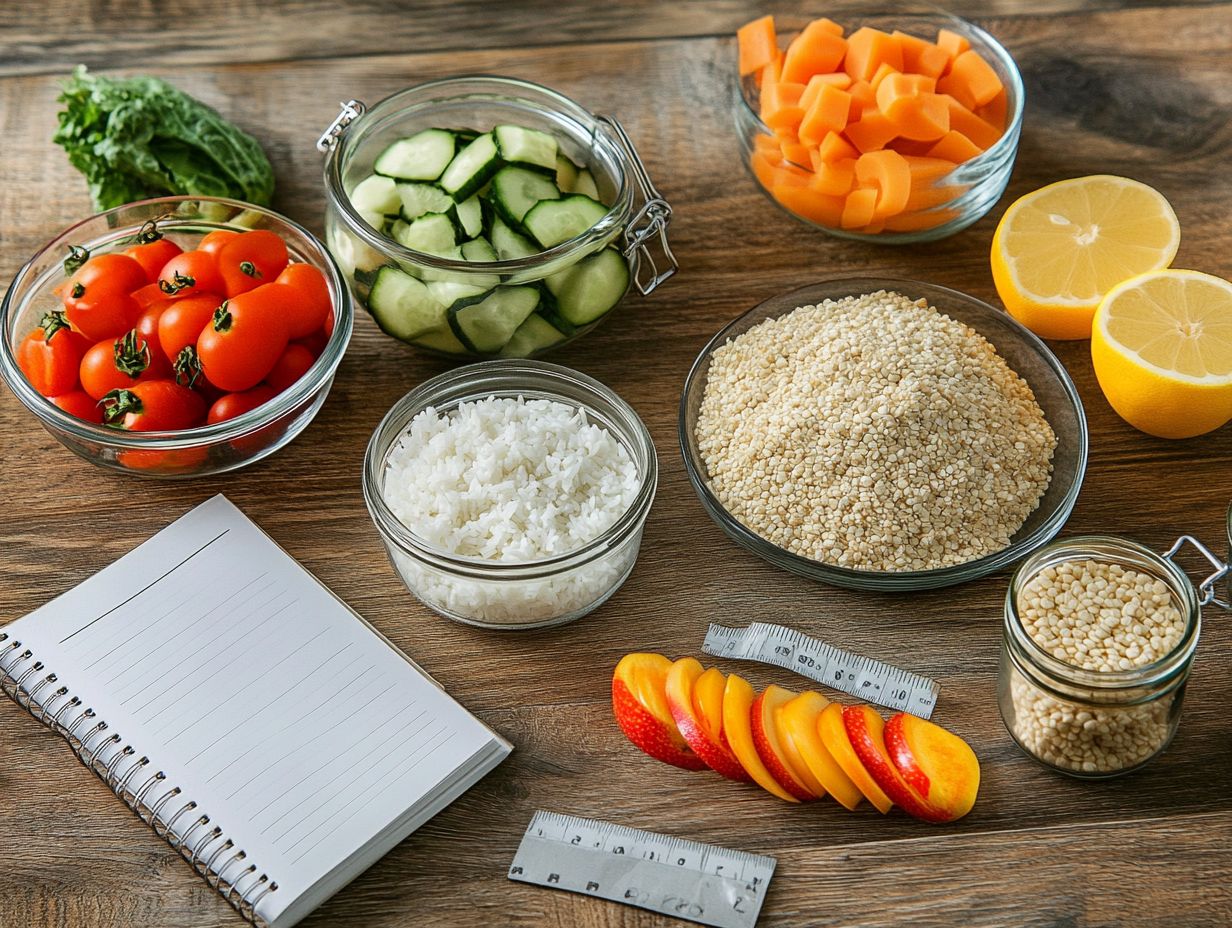
High-fiber plant foods, including many fruits and vegetables, are often avoided on a low-fiber vegan diet because they can contribute to digestive discomfort and irregular bowel movements.
For example, beans such as black beans and kidney beans, while nutritious, are high in fiber and may exacerbate bloating and gas for individuals with sensitive digestive systems. Similarly, nuts like almonds and walnuts, although rich in healthy fats, contain significant amounts of fiber that can lead to discomfort if consumed in large quantities.
Whole fruits, including apples and pears, are packed with fiber that benefits general digestion; however, they should be consumed sparingly on a low-fiber diet.
It is essential to recognize that while fiber is crucial for gut health, consuming high-fiber foods can lead to complications for those with certain digestive issues, making it important to limit these items accordingly in a low-fiber diet.
2. Processed Vegan Foods
While processed vegan foods are often marketed as healthy, they can be high in fiber and should be restricted on a low-fiber diet to promote better digestion.
These products include items such as veggie burgers, plant-based sausages, and granola bars, which offer convenience along with a plant-based alternative. It is essential for consumers to closely examine the nutritional information.
When reviewing food labels, one should consider not only the fiber content but also other ingredients, such as added sugars or preservatives, which may diminish the health benefits.
Choosing lower-fiber options, such as refined grains or nut-free snacks, can help those seeking to improve their gastrointestinal comfort.
Before making significant dietary changes, it is always advisable to consult with a registered dietitian or other health professionals.
3. Certain Whole Grains and Legumes
Certain whole grains and legumes, though generally healthy, are restricted on a low-fiber diet due to their higher fiber content, which can lead to digestive difficulties. For instance, while barley and quinoa are nutritious options, their rich insoluble fiber can exacerbate bloating and gas for individuals who are sensitive.
The same applies to legumes such as chickpeas and lentils, which are high in fiber and can cause specific digestive issues, necessitating dietary changes for better digestive comfort. The fiber in these foods may stimulate the digestive tract, sometimes resulting in discomfort and irregularity.
However, employing cooking methods such as soaking and sprouting can be beneficial, as these techniques break down some of the fiber and sugars that contribute to digestive problems, making the nutrients more accessible and gentler on the digestive system.
What Foods Can Be Included on a Low-Fiber Vegan Diet?
A low-fiber vegan diet is one that excludes fiber-rich foods while remaining nutritious and satisfying. This type of diet can be both nutritious and satisfying by incorporating a variety of low-fiber plant foods.
It typically includes a diverse selection of low-fiber plant options, vegan protein sources, and healthy fats, all of which provide essential nutrients while being gentle on the digestive system, aligning with plant-based diet principles.
Examples of low-fiber vegan foods that can be included in a balanced and enjoyable low-fiber vegan diet consist of those that are typically well-cooked, ripe, or soft enough to be considered low-fiber.
1. Low-Fiber Plant Foods
Low-fiber plant foods, such as cooked fruits and skinless vegetables, are excellent options for individuals following a low-fiber vegan diet, as they exert less strain on digestion while providing essential nutrients. These foods help maintain energy levels and promote overall health, making them an important part of meal planning.
Ripe bananas, which are soft and easy to digest, can be added to smoothies or mashed into breakfast bowls, offering hydration and sweetness.
Cooked carrots and zucchini, when peeled and steamed, retain their vitamins while being gentle on the stomach, making them suitable for soups or pureed into sauces, demonstrating effective cooking methods for low residue diet adherence.
Baked sweet potatoes, when peeled, serve as a great source of vitamins A and C, adding a delightful sweetness to any meal, fitting well within low-fiber food options.
Additionally, fruits such as applesauce and pears offer a variety of nutrients that are vital for a balanced low fiber vegan lifestyle. Incorporating low residue diet principles can be particularly beneficial for individuals with digestive issues such as Crohn’s disease and ulcerative colitis.
2. Vegan Protein Sources and Nutritional Needs
There are numerous vegan protein sources, including soft foods and supplements, that are low in dietary fiber and can help individuals meet their daily protein requirements without causing discomfort in the digestive system. These protein sources are crucial for maintaining muscle mass and overall health, especially when following a plant-based diet.
Tofu and tempeh are both excellent and filling protein sources, as they are rich in essential amino acids while remaining gentle on digestion. Additionally, certain protein powders, such as pea, rice, or hemp protein powders, can supplement daily protein intake without being too heavy on the digestive system. Including refined grains like white rice and pasta can also help meet nutritional needs without adding excessive fiber.
For healthcare providers and registered dietitians, it is crucial to ensure that patients on a low-fiber diet are still consuming adequate protein, which is essential for maintaining lean body mass, immune function, and overall health. These vegan sources play a vital role in a balanced diet and support overall digestive health.
3. Healthy Fats and Hydration

In a low-fiber vegan diet, incorporating healthy fats such as avocados and various oils is essential for meeting dietary requirements while ensuring easy digestion. Healthy fats also aid in the absorption of fat-soluble vitamins and play a role in maintaining overall GI health.
These fats supply the body with essential fatty acids that promote cellular health and enhance the palatability of meals, making dining more enjoyable. Alongside soft foods and well-cooked vegetables, they can improve meal satisfaction.
For instance, drizzling olive oil over roasted vegetables adds a savory flavor, while coconut milk can create a creamy and delightful texture in soups.
Healthy fats also assist with hydration and facilitate the absorption of fat-soluble vitamins A, D, E, and K, contributing to overall wellness.
By including these healthy fats, individuals on low-fiber diets can enjoy nutritious and satisfying meals.
How Can Someone Ensure Proper Nutrition on a Low-Fiber Vegan Diet and Avoid Nutrient Deficiencies?
Achieving proper nutrition on a low-fiber vegan diet requires careful planning to avoid potential nutrient deficiencies. It is important to consider the fiber content of foods and opt for nutrient-dense choices.
It is essential to incorporate nutrient-dense foods that provide a wide range of vitamins and minerals. Consulting with a registered dietitian can be beneficial in creating a balanced meal plan tailored to individual nutritional needs while steering clear of high-fiber foods that may adversely affect digestive health. Including fruits and vegetables that are low in fiber, as well as cooked fruits and canned vegetables, can help meet nutritional needs without causing discomfort.
1. Focus on Nutrient-Dense Foods
Nutrient-dense foods play a vital role in low-fiber diets as they help individuals meet their daily vitamin and mineral needs without adding excessive fiber that could exacerbate digestive issues. Health professionals recommend integrating soft foods and well-cooked vegetables into the diet for optimal digestive aid.
Including nutrient-dense options, such as avocados, in a low-fiber diet provides healthy fats and potassium, which promote heart health and facilitate the absorption of other nutrients.
Sweet potatoes are an excellent source of beta-carotene and vitamin C, beneficial for boosting immune function and promoting skin health within a low-fiber framework. They also help maintain regular bowel movements without irritating the digestive tract.
Eggs offer high-quality protein and essential B vitamins, making them a versatile ingredient that can be incorporated into a variety of meals. They are considered a staple in many low-fiber meal plans for their ease of digestion.
Additionally, lean meats and fish supply protein and important omega-3 fatty acids, which support brain health and help reduce inflammation in a low-fiber diet. Tender meats and refined grains like white bread and pasta can be included to further diversify meal options.
2. Consider Supplements for Nutritional Management
Yes, dietary supplements may be necessary for individuals on a low-fiber diet to address nutrient deficiencies and promote overall health.
For those following such a diet, various supplements are available to help meet their nutritional needs, including:
- fiber supplements (if needed to regulate bowel movements)
- multivitamins
- probiotics
- omega-3 fatty acids
These products can provide essential nutrients that might otherwise be lacking in their daily diets, such as iron, calcium, and B vitamins. It is important for anyone considering these supplements to first consult with a healthcare provider or a registered dietitian, as they can best assess individual health needs and offer dietitian guidance.
3. Consult with a Registered Dietitian
Consulting with a registered dietitian is essential to ensure that a low-fiber diet meets all nutritional requirements and accommodates personal health conditions and preferences.
These trained professionals possess the expertise to navigate the often confusing array of food choices and their components. They assess individual situations and create customized meal plans that address specific health conditions while considering an individual’s lifestyle and food preferences.
This personalized approach is crucial to ensure that essential nutrients are not unnecessarily restricted alongside those that need to be reduced, ultimately leading to better health outcomes. Additionally, a registered dietitian provides education on food selection and preparation.
What Are Some Sample Meal Plans for a Low-Fiber Vegan Diet?
Sample meal plans for a low-fiber vegan diet are developed by focusing on plant-based foods that have a soft texture and can be transformed into softer dishes through cooking methods like steaming, boiling, and pureeing.
These meal plans should also take into account the importance of hydration and proper nutrition while avoiding high-fiber foods that could cause discomfort.
1. Breakfast and Hydration
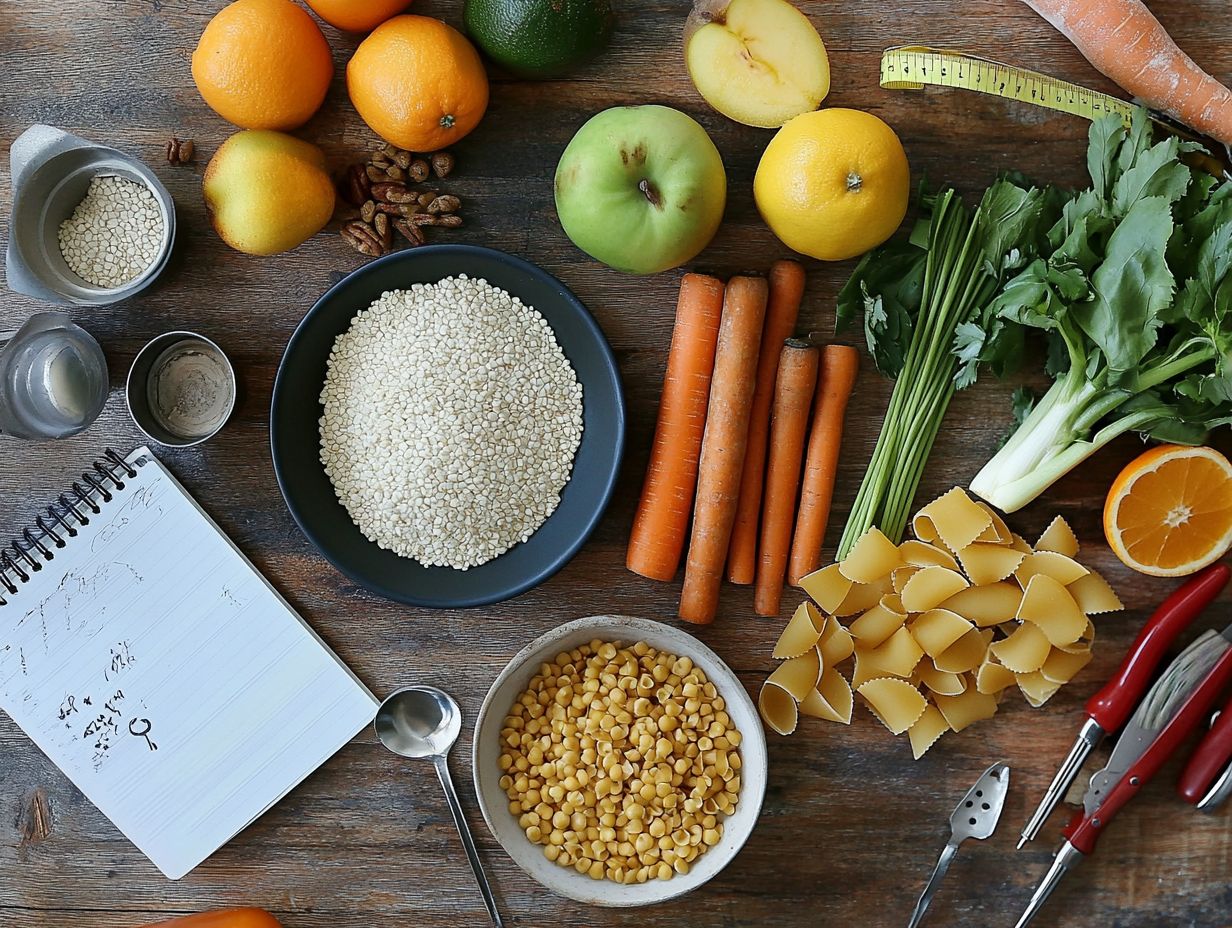
Breakfast on a low-fiber vegan diet can include soft foods such as oatmeal made with almond milk, blended fruit smoothies, or well-cooked polenta, all of which provide essential nutrients while ensuring easy digestion.
Incorporating options like silken tofu scrambles or creamy rice pudding can add delightful variety to the morning meal. Silken tofu, lightly seasoned and sautéed, is rich in protein and naturally low in fiber, making it a versatile choice.
Alternatively, rice pudding made with coconut milk offers a comforting start to the day, supplying healthy fats and a hint of sweetness. It is important to accompany these dishes with hydrating options, such as herbal teas or infused waters, to support overall well-being while keeping fiber intake in check.
This approach allows for a satisfying and nutritious breakfast experience.
2. Lunch and Dietary Fiber Considerations
A healthy lunch on a low-fiber vegan diet can feature a creamy vegetable soup made from well-cooked, skinless vegetables, served alongside soft bread or crackers for a filling and easy-to-digest meal. Incorporating fruit juices can also enhance the meal’s nutrient profile while staying within low-fiber guidelines.
A side of mashed avocado adds both creaminess and healthy fats that are beneficial for overall health.
Additionally, a refreshing smoothie made from ripe bananas blended with coconut yogurt can enhance hydration, providing a rich source of potassium without being too fibrous.
Incorporating silky tofu into a vegetable stir-fry can boost protein intake while ensuring the meal remains easy to digest, creating a balanced and nutritious option that aligns well with a low-fiber dietary preference.
3. Dinner and Digestive Health
Dinner options for low-fiber vegan meals include:
- Mashed potatoes with plant-based gravy
- Soft tofu stir-fry with tender vegetables
- Smooth risotto made from low-fiber grains
Plus these delightful selections, creamy soups prepared from blended vegetables like zucchini or carrots offer a soothing and easy-to-digest alternative. Baking or steaming vegetables such as carrots, squash, and bell peppers can enhance their natural sweetness while making them gentler on the digestive system. Dairy products like lactose-free milk can also be included if tolerated.
Choosing cooking methods like sautéing or simmering can also elevate flavors without compromising the low-fiber requirement. By embracing these techniques, individuals following such dietary guidelines can enjoy a satisfying and nutritious dinner that nourishes the body without causing discomfort.
What Are Some Tips for Managing a Low-Fiber Vegan Diet?
Successfully managing a low-fiber vegan diet requires proactive planning and a thorough understanding of food options and cooking methods. To navigate this dietary approach effectively, it is essential to follow specific tips and health benefits guidelines.
Reading food labels, selecting suitable cooking methods, and consulting health professionals can significantly enhance the success of this diet while ensuring that nutritional needs are met.
1. Read Labels Carefully
Reading food labels is crucial for low-fiber dieters as it helps them identify foods that contain high amounts of dietary fiber, which could irritate their digestive systems. Paying attention to nutritional information and fiber content is essential for making informed food choices.
Accessing nutritional information significantly influences dietary choices for low-fiber dieters by revealing fiber content and providing details about other nutrients that may impact digestive health.
Understanding which ingredients contribute to excess fiber is essential for low-fiber dieters who aim to create balanced meals, as some foods that appear healthy can actually be harmful.
Paying close attention to serving sizes will assist low-fiber dieters in controlling their fiber intake, allowing them to stay within safe limits and avoid foods high in unwanted ingredients that may exacerbate their symptoms.
2. Cook at Home
Cooking at home allows individuals on a low-fiber diet to have greater control over the ingredients and cooking methods, ensuring that meals are tailored to their specific dietary needs. This personalized approach not only encourages healthier eating habits but also enables the preparation of a variety of delicious and satisfying dishes. Incorporating dietary changes and health tips can further enhance digestive health and overall well-being.
By incorporating soft foods such as pureed vegetables, tender meats, and easily digestible grains, one can create meals that are both enjoyable and gentle on the digestive system. Techniques like steaming, slow cooking, or blending can enhance flavors while ensuring the softness required for these diets.
Simple recipes, such as creamy mashed potatoes, chicken broth with noodles, or velvety zucchini soup, can elevate the dining experience, making it both nutritious and comforting.
3. Experiment with Different Foods for Digestive Health
Experimenting with different foods can enhance the appeal and variety of a low-fiber diet, allowing individuals to discover new tastes and textures while adhering to their dietary restrictions. It’s important to balance fiber intake to maintain GI health and consult with a health care provider regarding any dietary changes needed, especially for digestive issues such as Crohn’s disease or ulcerative colitis.
Incorporating a wide range of low-fiber ingredients, such as ripe bananas, well-cooked vegetables, canned vegetables, and soft cheeses, can transform meal preparation into an exciting culinary adventure. Seasonings and herbs can also be used to elevate the flavors of these foods; for example, adding garlic or buttery herbs can enhance even the simplest dishes. Additionally, understanding food labels for fiber content and nutritional information is crucial for creating a balanced meal plan.
Encouraging the palate to explore new textures—whether through creamy soups or smooth puddings—can further enrich the dining experience. Gradually introducing different low-fiber foods, including dairy products, refined grains, and tender meat, can help increase meal variety while making the overall dining experience enjoyable and interesting. For individuals on a low residue diet, incorporating soft foods and cooked fruits can aid the digestive system while preventing constipation.

